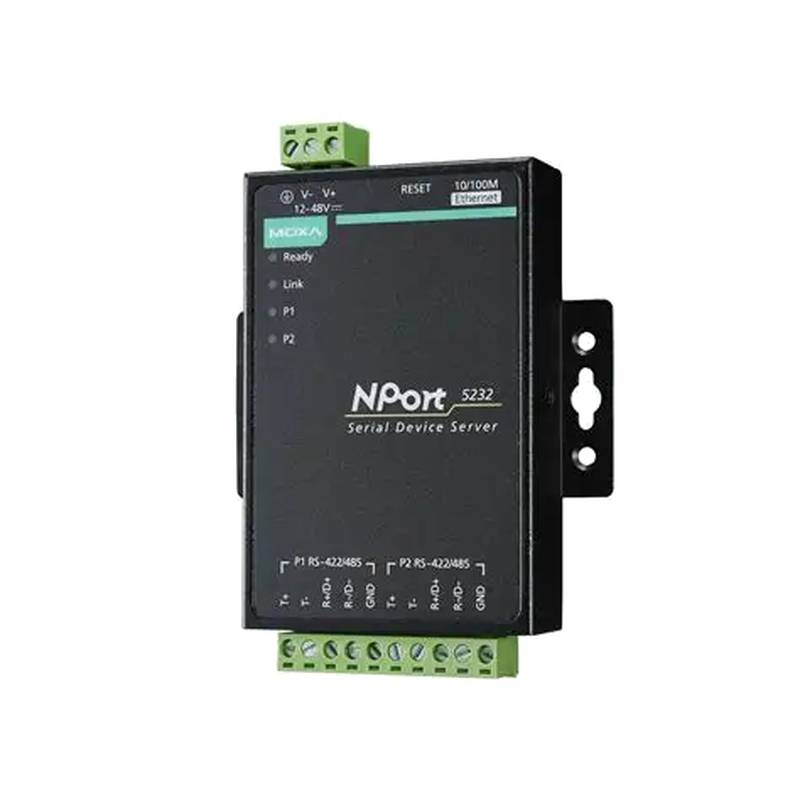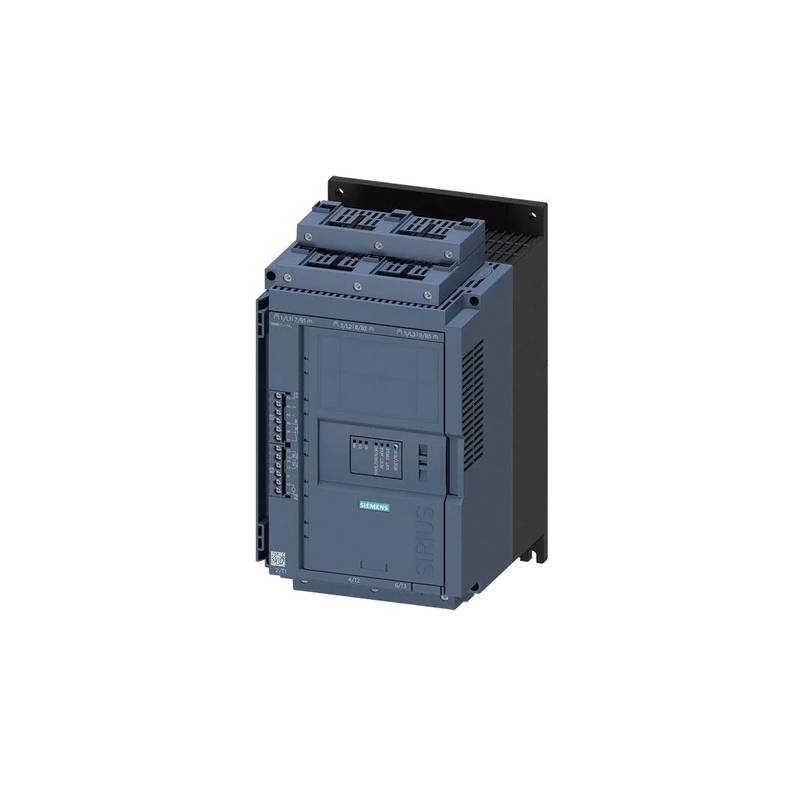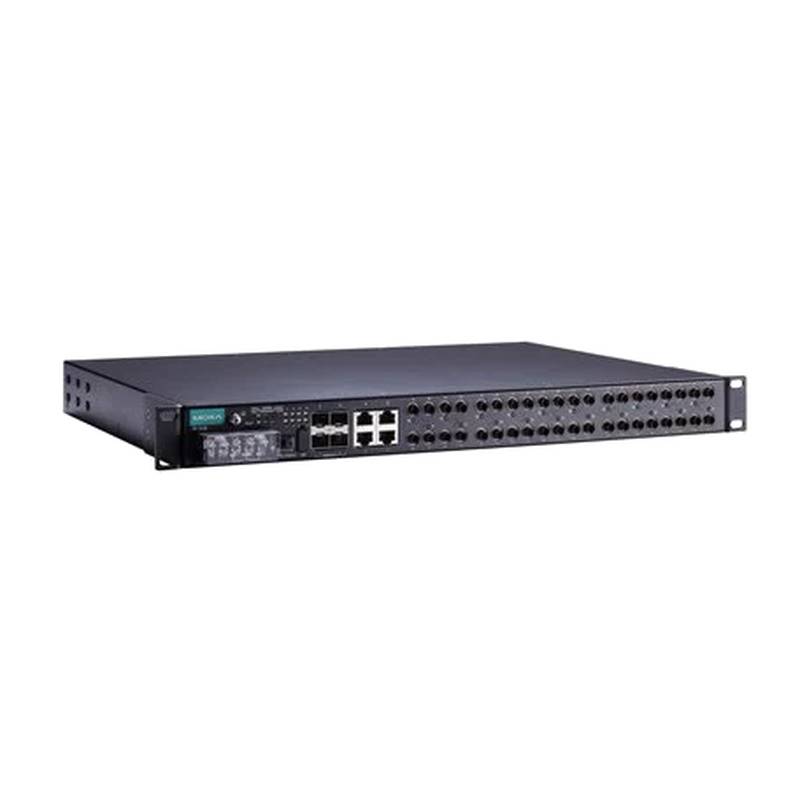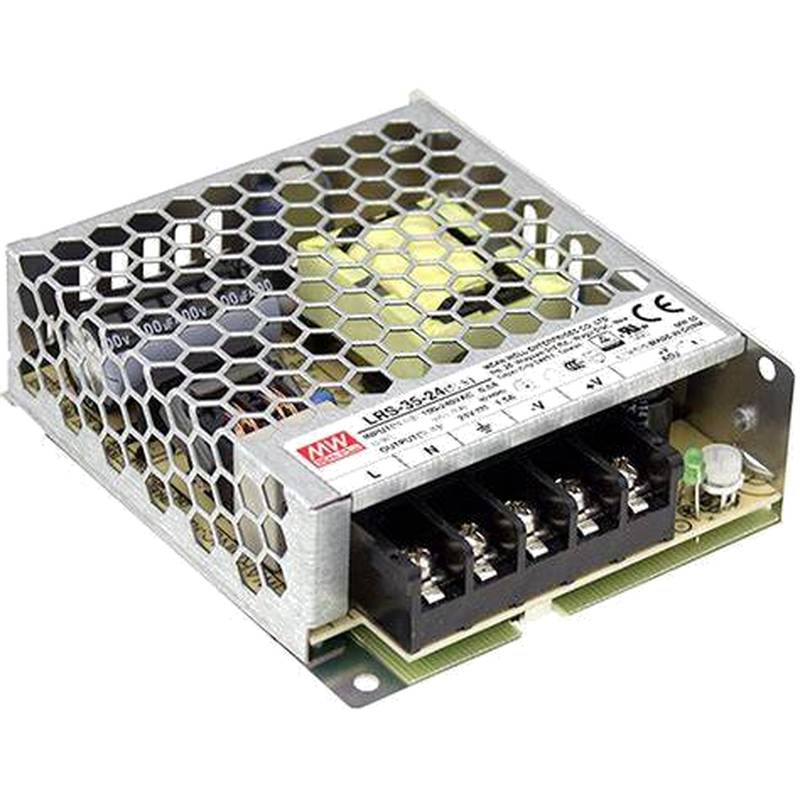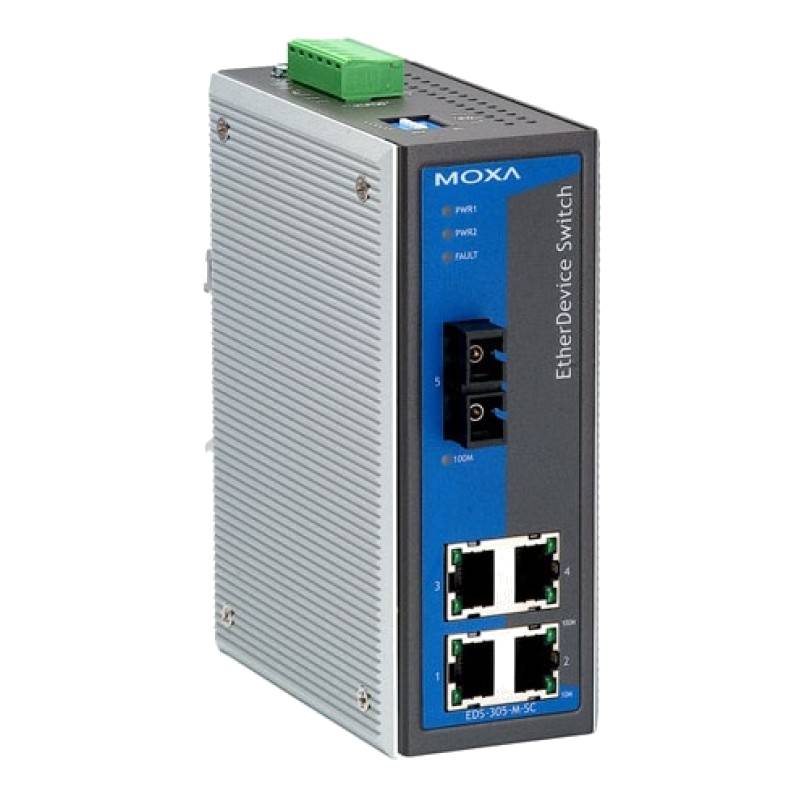
The Moxa NPort 5250A Industrial Serial Device Networking Server stands as a robust solution for integrating legacy serial devices into modern Ethernet networks. Its key advantages lie in its dual Ethernet ports, enabling ring redundancy for enhanced network uptime, and its support for a wide array of serial interface types (RS-232/422/485) within a single unit. The device boasts an impressive operating temperature range, making it suitable for harsh industrial environments, and offers flexible mounting options. Its core features include TCP/IP, UDP/IP, and HTTP protocol support, along with secure communication protocols like SSH and SSL/TLS. The NPort 5250A is designed for high-density serial device connectivity, typically supporting up to two serial ports, each configurable independently. Its technical specifications are engineered for demanding industrial applications, emphasizing reliability and performance.
Product Specifications
| Feature | Specification |
| :-------------------- | :--------------------------------------------------- |
| Serial Ports | 2-port RS-232/422/485 |
| Ethernet Interface | 2 x 10/100BaseT(X) |
| Protocol Support | TCP/IP, UDP/IP, HTTP, ARP, ICMP, DHCP, BOOTP, DNS, Telnet, (SNMP MIB-II) |
| Baud Rate | 50 bps to 921.6 kbps |
| Data Bits | 5, 6, 7, 8 |
| Parity | None, Even, Odd, Space, Mark |
| Stop Bits | 1, 1.5, 2 |
| Flow Control | RTS/CTS, XON/XOFF, None |
| Serial Connector | DB9 male |
| Ethernet Connector | RJ45 |
| Power Input | 12-48 VDC |
| Operating Temperature | -40 to 75 °C (-40 to 167 °F) |
| Mounting | DIN-rail, Wall-mount |
| Dimensions | 37.5 x 137 x 112 mm (1.48 x 5.39 x 4.41 in) |
| Warranty | 5 years |
Core Features & Market Positioning
The Moxa NPort 5250A differentiates itself through its robust industrial design and advanced networking capabilities. Its dual Ethernet ports are a significant competitive advantage, enabling rapid network recovery through Moxa's proprietary ring redundancy protocols, ensuring minimal downtime in critical operations. This feature, combined with a wide operating temperature range from -40°C to 75°C, positions the NPort 5250A as a reliable choice for deployments in challenging environments like oil and gas, manufacturing automation, and transportation. The device's ability to support multiple serial interface types (RS-232, RS-422, and RS-485) on each port provides exceptional flexibility, allowing seamless integration of diverse legacy equipment into a unified IP network without requiring hardware replacements. This versatility, coupled with Moxa's reputation for industrial-grade reliability and long-term support, makes it a preferred solution for system integrators and industrial IT professionals prioritizing stable, secure, and efficient serial-to-Ethernet conversion.
Key Application Scenarios
The Moxa NPort 5250A finds its primary application in bridging the gap between serial-based industrial equipment and modern IP networks. In manufacturing environments, it is crucial for connecting Programmable Logic Controllers (PLCs), sensors, and SCADA systems to a central monitoring and control platform via Ethernet, enabling real-time data acquisition and remote management. In the energy sector, it facilitates the integration of meters, remote terminal units (RTUs), and control panels in substations and field sites, allowing for efficient data collection and operational adjustments. Furthermore, its rugged design makes it suitable for transportation systems, such as railway signaling, traffic control systems, and passenger information displays, where reliable serial communication is essential for safety and operational efficiency. Its ability to handle various serial protocols and electrical interfaces ensures compatibility with a broad spectrum of industrial machinery and legacy systems.
Practical System Integration Guidance
Integrating the Moxa NPort 5250A into an industrial network is streamlined through Moxa's suite of management tools. Initial setup typically involves connecting the device to the network via its RJ45 Ethernet ports and configuring its IP address using Moxa's Device Search utility or by setting a default IP address. For serial port configuration, users can access the device's web console or command-line interface to define parameters such as baud rate, data bits, parity, and stop bits, ensuring they match the connected serial device's requirements. The NPort 5250A supports various operating modes, including Real COM, Virtual COM, TCP Server, TCP Client, UDP Server, and UDP Client, allowing for flexible network topologies. For instance, using the Virtual COM mode enables existing serial communication software to function seamlessly over the network by creating virtual serial ports on a host PC. Wiring typically involves standard DB9 connectors for the serial side and RJ45 for Ethernet, with appropriate industrial-grade cables for power and network connections.
Operation and Risk Mitigation
Operating the Moxa NPort 5250A requires attention to network security and environmental conditions. To mitigate risks associated with unauthorized access, it is recommended to configure strong passwords, disable unused services, and implement network segmentation. For sensitive applications, leveraging the device's built-in SSH and SSL/TLS encryption capabilities can secure data transmission over the network. Physically, the device's wide operating temperature range of -40 to 75°C allows for deployment in challenging industrial settings, but proper ventilation and protection from excessive dust, moisture, and electromagnetic interference should still be considered to ensure long-term reliability. In terms of troubleshooting, common issues often relate to incorrect serial port settings or network IP conflicts. Users can access the device's event logs via its web interface to diagnose problems, and Moxa provides detailed documentation and support resources for resolving specific error codes or operational anomalies.
Scalability & Long-Term Value
The Moxa NPort 5250A offers significant long-term value through its inherent scalability and compatibility. Its ability to connect serial devices to an Ethernet network is a foundational step for implementing Industrial IoT (IIoT) and Industry 4.0 initiatives, allowing for data aggregation and analysis from previously isolated systems. The device supports Moxa's industrial protocols and management platforms, facilitating integration into larger supervisory control and data acquisition (SCADA) systems or manufacturing execution systems (MES). For organizations with expanding serial device inventories, the NPort series offers a range of models with varying port densities and features, allowing for a scalable deployment strategy. Furthermore, Moxa's commitment to long product lifecycles and regular firmware updates ensures that the NPort 5250A remains a relevant and secure component within evolving industrial automation architectures, providing a cost-effective solution for modernizing legacy infrastructure.
FAQs
Q1: What serial protocols does the Moxa NPort 5250A support?
The NPort 5250A supports standard serial communication protocols like RS-232, RS-422, and RS-485, offering flexibility for diverse industrial equipment. It allows users to configure data bits, parity, and stop bits to match specific device requirements precisely.
This configuration ensures reliable data transmission between the serial device and the Ethernet network, minimizing errors during conversion. The device supports baud rates up to 921.6 kbps for high-speed data transfer needs.
Its ability to handle multiple serial standards within a single unit reduces the need for multiple converters, simplifying infrastructure and lowering costs. This versatility is key for integrating legacy systems.
Q2: How do I configure the IP address of the Moxa NPort 5250A?
You can configure the IP address using Moxa's free Device Search utility software, which scans your network for connected Moxa devices. Alternatively, you can set a default IP address manually via a serial console connection before network deployment.
Once discovered, the IP address can be easily modified through the device's web-based management interface, providing a user-friendly graphical environment for network settings. This interface also allows for other crucial network configurations.
For automated deployments, static IP assignment or DHCP with reservations can be employed to ensure consistent network addressing for multiple NPort units. This is vital for large-scale industrial networks.
Q3: Can the Moxa NPort 5250A provide network redundancy?
Yes, the Moxa NPort 5250A features dual Ethernet ports that support Moxa's patented Turbo Ring and Turbo Chain network redundancy technologies. This ensures rapid network recovery in case of a link failure, minimizing downtime.
With recovery times as low as 10 milliseconds, these redundancy protocols are critical for applications where continuous operation is paramount, such as in process control or critical infrastructure monitoring. This enhances system resilience.
This capability allows the NPort 5250A to be integrated into ring or chain topologies, providing a robust and fault-tolerant network solution essential for industrial automation. It simplifies complex network designs.
Q4: What operating temperature range does the NPort 5250A support?
The Moxa NPort 5250A is designed to operate reliably in extreme industrial environments, with a wide operating temperature range of -40°C to 75°C (-40°F to 167°F). This broad range ensures stability even in harsh conditions.
This capability makes it suitable for deployment in applications located in outdoor enclosures, unheated factories, or other areas subject to significant temperature fluctuations without compromising performance. It offers great deployment flexibility.
Proper ventilation should still be considered in extreme conditions to ensure optimal device longevity and consistent performance, even within its specified operating limits. This helps prevent overheating or overcooling.
Q5: How is the Moxa NPort 5250A powered?
The Moxa NPort 5250A typically accepts a wide DC input voltage range, commonly from 12 to 48 VDC. This allows for flexible power sourcing from various industrial power supplies or battery backups.
It features a terminal block connector for secure and reliable power connections in industrial settings, ensuring a stable power supply for uninterrupted operation of the serial-to-Ethernet conversion. This is a standard industrial connection.
Redundant power inputs might be available on some models or through external power management solutions, further enhancing the device's reliability and operational continuity in critical applications. This adds an extra layer of safety.
Q6: What mounting options are available for the NPort 5250A?
The Moxa NPort 5250A offers versatile mounting options to accommodate diverse industrial cabinet and control panel configurations. It typically includes integrated DIN-rail mounting capabilities for quick installation on standard mounting rails.
Additionally, it often comes with or supports optional wall-mount brackets, allowing for flexible placement on flat surfaces or within enclosures where DIN-rail mounting is not feasible. This provides deployment flexibility.
These mounting choices ensure that the NPort 5250A can be securely and conveniently installed in a wide range of industrial environments, simplifying system integration and maintenance procedures. Proper mounting is key for reliability.
Q7: Does the NPort 5250A support secure communication protocols?
Yes, the Moxa NPort 5250A supports secure communication protocols like SSH (Secure Shell) and SSL/TLS (Secure Sockets Layer/Transport Layer Security). These protocols encrypt data transmitted over the network, protecting sensitive information.
Implementing SSH and SSL/TLS encryption is crucial for preventing eavesdropping and man-in-the-middle attacks, ensuring the confidentiality and integrity of data exchanged between serial devices and the network. Security is a priority.
By enabling these security features, users can confidently integrate legacy serial devices into modern, potentially less secure network infrastructures without compromising operational safety or data privacy. This enhances overall system security.
Q8: What is the warranty period for the Moxa NPort 5250A?
Moxa typically offers a substantial warranty period for its industrial networking products, including the NPort 5250A. This often extends to 5 years, reflecting the product's robust design and Moxa's commitment to quality and reliability in industrial applications.
This extended warranty provides users with long-term peace of mind, ensuring support and protection against manufacturing defects for an extended operational lifespan. It signifies product confidence.
The warranty terms and conditions should be reviewed upon purchase, but the standard long warranty period highlights the NPort 5250A as a durable and dependable investment for industrial automation projects. It's a key factor for TCO.
Q9: How does the NPort 5250A handle different serial interface types (RS-232, RS-422, RS-485)?
Each serial port on the NPort 5250A is independently configurable to support RS-232, RS-422, or RS-485 electrical interfaces. This is typically selected through DIP switches or software configuration, offering great flexibility.
This means a single NPort 5250A can connect to a mix of different serial devices simultaneously, such as an RS-232 barcode scanner and an RS-485 sensor network, without needing separate converters for each type. It simplifies integration.
The device's firmware manages the specific communication protocols and electrical signaling for each selected serial standard, ensuring seamless data conversion and transmission over the Ethernet network. This ensures compatibility.
Q10: What operating modes are available for the Moxa NPort 5250A?
The Moxa NPort 5250A supports several key operating modes to suit various network architectures and application requirements. These include Real COM, Virtual COM, TCP Server, TCP Client, UDP Server, and UDP Client.
The Real COM and Virtual COM modes allow the serial device to appear as a standard COM port on a host computer, enabling legacy applications to communicate over Ethernet without modification. This is vital for migration.
TCP Server/Client and UDP modes offer direct network socket communication, providing flexibility for custom applications or when interfacing with network-aware devices, facilitating robust data exchange protocols. This offers advanced control.














